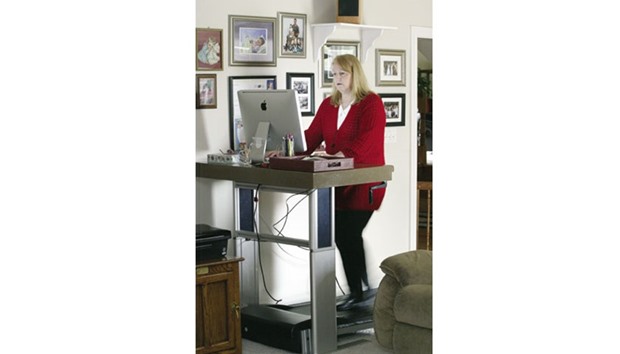Sitting is the new smoking – blamed for increasing the risk of heart disease and cancer, as well as diabetes and obesity. Health guidelines suggest we should spend 150 minutes a week in moderate exercise, but many of us sit down for more than half the working day – e-mail means we don’t even have to get up to talk to anyone. So it is not surprising that there is a gap in the market.
Stand-up, sit-stand and treadmill desks are all the rage. Google and Microsoft have allegedly bought stacks of treadmill desks – modified treadmill bases attached to work surfaces. The manufacturer of TrekDesk says that a treadmill-desk set at a walking speed of 1.5km an hour will burn 2.6 calories a minute. Such energy expenditure does not come cheap: desks cost upwards of £1,000. But do they make people more active and healthier, or are they this year’s corporate gimmick?
The research so far is inconclusive. The benefits may be more myth than reality. A systematic review by Cochrane researchers looked at 26 studies with 2,174 people. They found that sit-stand desks reduced sitting by between 30 minutes and two hours a day. While this sounds impressive, the researchers say the studies mostly did not deliver the up-to-four-hours of standing that experts recommend.
Standing desks were also not found to have much benefit in weight reduction – if an average-sized man and woman spent half of their eight-hour working day standing, they would spend an additional 20 kilocalories and 12 kilocalories each. This, point out the researchers, is not enough to prevent obesity or type 2 diabetes. Prolonged standing may also be difficult for people with low back pain.
Treadmill work stations, though, were found to reduce sitting by nearly half an hour in the Cochrane review and another systematic review found that they particularly benefited obese people, improving their levels of good cholesterol and reducing their waist circumferences.
So much for the physical effects, but what about productivity and brainpower? Exercise is traditionally thought to improve the ability to think – but generally only after you have stopped doing it. A study in Plos One of 76 people randomly assigned to a treadmill (moving at 1.5mph) or a sitting desk found that the sedentary group did better at recalling lists of words and working out mental maths problems. It was easier to concentrate and remember from a sitting position. Unsurprisingly, it was also easier to type faster without making mistakes.
So, while the benefits of standing desks may be overstated, the risks of sitting are not. You can take walking breaks throughout the day and use the stairs, whatever desk you have.- Guardian News and Media

A woman working at a treadmill desk at home.
